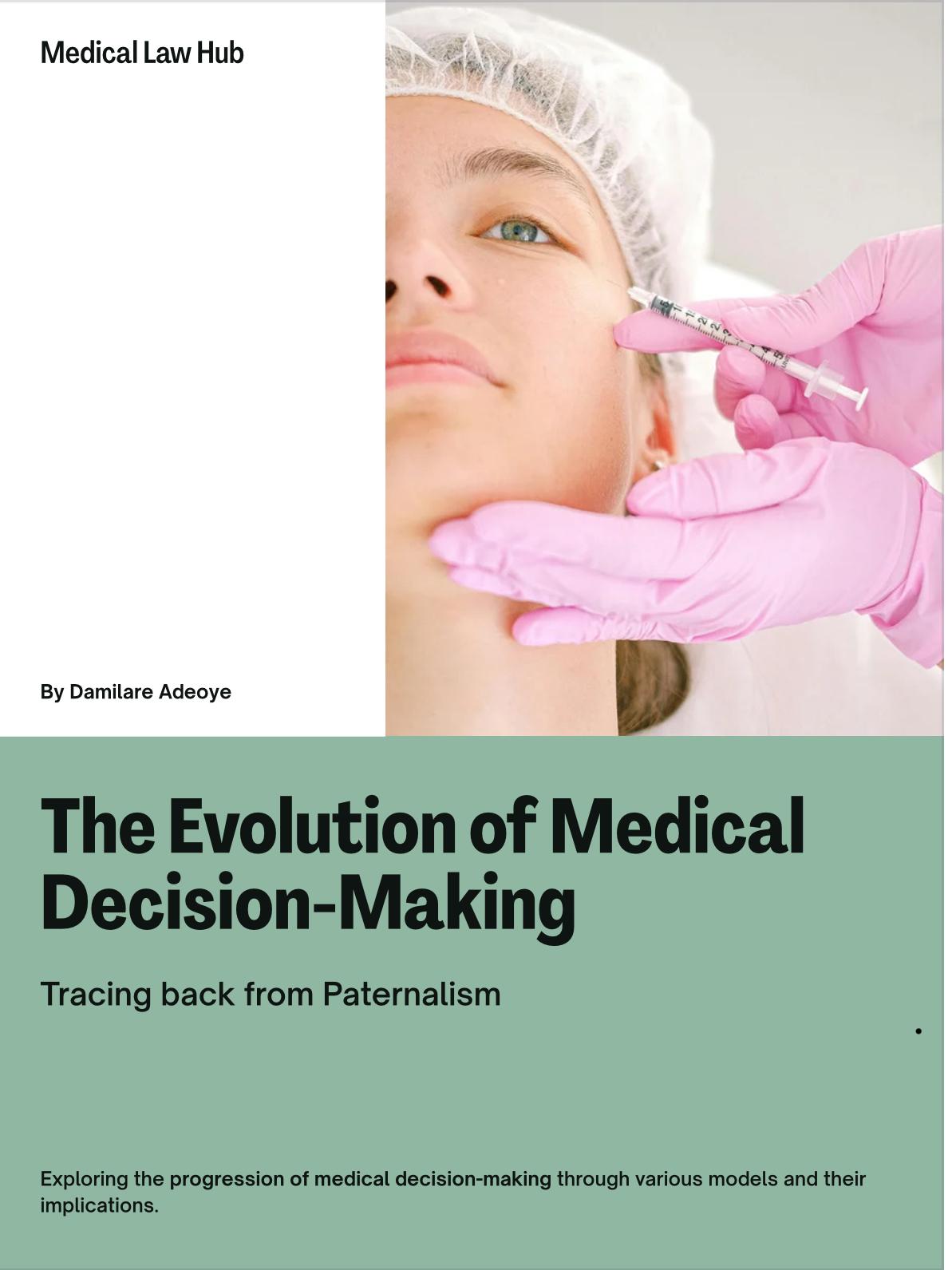EVOLUTION OF MEDICAL DECISION-MAKING: TRACING PATERNALISM, CONSENT, INFORMED CONSENT, AND PRESUMED CONSENT IN MEDICAL LAW
- home
- EVOLUTION OF MEDICAL DECISION-MAKING: TRACING PATERNALISM, CONSENT, INFORMED CONSENT, AND PRESUMED CONSENT IN MEDICAL LAW

- Jun 19th 2025
- By Damilare Adeoye, Esq
EVOLUTION OF MEDICAL DECISION-MAKING: TRACING PATERNALISM, CONSENT, INFORMED CONSENT, AND PRESUMED CONSENT IN MEDICAL LAW
Introduction
Over the last century, medical law has evolved significantly, reflecting changing societal values, ethical principles, and legal standards. At the centerof this evolution are the concepts of paternalism, Autonomy, consent, informed consent, and, more recently, presumed consent. These concepts shape the relationship between healthcare providers and patients, balancing individual autonomy with societal and medical interests.
This article traces their development, interplay, and implications in medical law, drawing on historical context, legal milestones, and ethical debates.
1. Paternalism in Medical Law
Paternalism in medicine refers to the practice where healthcare professionals make decisions on behalf of patients, assuming they know what is best for the patient’s health and well-being. Historically, paternalism dominated medical practice, rooted in the Hippocratic tradition, which emphasized the physician’s duty to act in the patient’s best interest.
• Historical Context: In the early 20th century and before, medical paternalism was the norm. Doctors, viewed as authoritative figures, often withheld information or made decisions without consulting patients. For example, patients with terminal illnesses were frequently not informed of their diagnoses to “protect” them from distress. This approach was justified by the belief that physicians possessed superior knowledge and moral authority.
• Legal and Ethical Challenges: Paternalism began to face scrutiny in the mid-20th century as patient autonomy gained prominence. Landmark cases, such as Canterbury v. Spence(1972) in the United States, challenged the notion that doctors could unilaterally decide what was best for patients. The court emphasized that patients have a right to make informed decisions about their treatment, marking a shift away from paternalism.
• Ethical Debate: Paternalism conflicts with the principle of autonomy, a cornerstone of modern medical ethics as outlined in documents like the Declaration of Helsinki (1964, revised multiple times). Critics argue that paternalism undermines trust and disempowers patients, while defenders claim it can be justified in cases where patients lack capacity or face immediate harm.
2. Consent in Medical Law
Consent, the agreement of a patient to undergo a medical procedure or treatment, emerged as a counterpoint to paternalism, emphasizing patient agency. Consent is a fundamental principle in medical law, ensuring that patients are active participants in their care.
• Historical Development: The concept of consent has roots in common law, particularly in the principle that individuals have a right to bodily integrity. Early legal cases, such as Slater v. Baker and Stapleton (1767) in England, established that performing medical procedures without patient consent could constitute battery.
• Legal Framework: Consent must be voluntary, given by a competent individual, and based on adequate information. In many jurisdictions, consent can be express (written or verbal) or implied (e.g., a patient extending their arm for a blood draw). Legal standards vary, but failure to obtain valid consent can result in liability for negligence or assault.
• Challenges: Consent raised questions about what constitutes “adequate” information and how to ensure patients understand the implications of their decisions. This led to the development of the doctrine of informed consent.
3. Informed Consent
Informed consent builds on the principle of consent by requiring that patients receive sufficient information to make autonomous decisions. It represents a shift from passive consent to an active, informed process, further eroding paternalistic practices.
• Legal Milestones: The term “informed consent” gained prominence in the United States with Salgo v. Leland Stanford Jr. University Board of Trustees (1957), where the court ruled that physicians must disclose relevant information about risks, benefits, and alternatives to proposed treatments. In the UK, the Bolam v. Friern Hospital Management Committee(1957) case initially set a standard that disclosure should align with what a reasonable doctor would provide, but this was later refined in Montgomery v. Lanarkshire Health Board(2015), which emphasized a patient-centered standard of disclosure.
• Elements of Informed Consent: Modern medical law requires that informed consent includes:
o Disclosure: Information about the procedure, risks, benefits, and alternatives.
o Capacity: The patient’s ability to understand and make decisions.
o Voluntariness: Freedom from coercion or undue influence.
• Global Standards: International frameworks, such as the Declaration of Geneva (1948, revised) and the Declaration of Helsinki, reinforce informed consent as a cornerstone of ethical medical practice. However, cultural differences affect its application, with some societies prioritizing communal decision-making over individual autonomy.
• Challenges: Informed consent faces practical challenges, such as ensuring comprehension in patients with limited health literacy or in emergency situations where time is constrained. Legal cases like Reibl v. Hughes (1980) in Canada clarified that physicians must tailor information to the patient’s needs and understanding.
4. Presumed Consent
Presumed consent, also known as “opt-out” consent, is a relatively recent development in medical law, primarily applied to organ donation. Under this model, individuals are assumed to consent to certain medical interventions (e.g., organ donation after death) unless they explicitly opt out.
• Historical Context: Presumed consent emerged in response to organ shortages, with countries like Spain adopting opt-out systems in the late 20th century. Spain’s success in increasing organ donation rates inspired other nations, such as Wales (2015) and England (2020), to implement similar systems.
• Legal Framework: In presumed consent systems, legislation establishes a default assumption of consent for organ donation, but individuals can register their refusal. For example, the UK’s Organ Donation (Deemed Consent) Act 2019 applies to adults who have not opted out, with safeguards for vulnerable groups and family consultation.
• Ethical Considerations: Presumed consent raises ethical debates about autonomy versus societal benefit. Proponents argue it respects individual choice while addressing public health needs, as seen in studies showing higher donation rates in opt-out systems (e.g., Rithaliaet al., 2009). Critics contend it risks undermining autonomy by assuming consent without explicit affirmation, particularly in populations with low awareness of opt-out processes.
• Global Variations: Presumed consent is not universally adopted. Countries like the United States and Canada maintain opt-in systems, requiring explicit consent. Cultural and religious beliefs influence acceptance, with some communities opposing presumed consent on ethical grounds.
Interplay and Evolution
The transition from paternalism to consent, informed consent, and presumed consent reflects a broader shift toward patient autonomy in medical law. Paternalism, once the default, has been largely supplanted by informed consent, which empowers patients to make decisions based on transparent information. Presumed consent, while controversial, represents a pragmatic approach to balancing individual rights with collective needs, particularly in organ donation.
• Tensions: The move away from paternalism has not eliminated tensions. For example, in emergency settings, obtaining informed consent may be impractical, leading to reliance on implied or presumed consent. Similarly, presumed consent systems must ensure robust public education to avoid undermining trust.
• Cultural and Legal Diversity: Different jurisdictions balance these concepts differently. For instance, Japan’s medical culture retains elements of paternalism, with family involvement in decision-making, while Western countries emphasize individual autonomy. Legal standards, such as the UK’s Mental Capacity Act 2005, provide frameworks for decision-making when patients lack capacity, blending autonomy with best-interest considerations.
Conclusion
The evolution of paternalism, consent, informed consent, and presumed consent in medical law reflects a dynamic interplay between ethical principles, legal standards, and societal needs. Paternalism, once dominant, has given way to a patient-centered model emphasizing informed consent, with presumed consent emerging as a controversial yet innovative approach to public health challenges. As medical law continues to evolve, ongoing debates about autonomy, capacity, and societal benefit will shape the future of these concepts.
References:
1. Canterbury v. Spence, 464 F.2d 772 (D.C. Cir. 1972).
2. Salgo v. Leland Stanford Jr. University Board of Trustees, 154 Cal. App. 2d 560 (1957).
3. Montgomery v. Lanarkshire Health Board[2015] UKSC 11.
4. Bolam v. Friern Hospital Management Committee [1957] 1 WLR 582.
5. Reibl v. Hughes [1980] 2 SCR 880.
6. Declaration of Helsinki (World Medical Association, 1964, revised).
7. Rithalia, A., et al. (2009). “Impact of presumed consent for organ donation on donation rates: A systematic review.” BMJ, 338, a3162.
8. Organ Donation (Deemed Consent) Act 2019(UK).
9. Mental Capacity Act 2005 (UK).

Speak With Our
Contact Us

